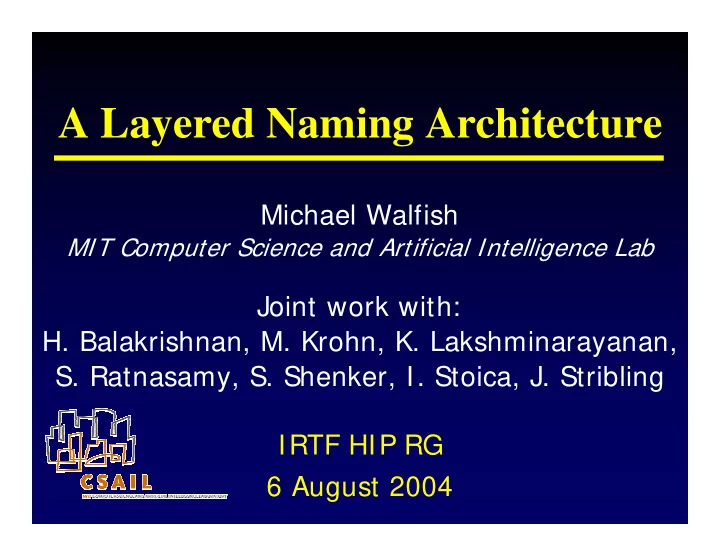

A Layered Naming Architecture Michael Walfish MIT Computer Science and Artificial Intelligence Lab Joint work with: H. Balakrishnan, M. Krohn, K. Lakshminarayanan, S. Ratnasamy, S. Shenker, I. Stoica, J. Stribling IRTF HIP RG 6 August 2004
Outline I. Overview of “Layered Naming Architecture” II. Application-level example III. Network-level examples
“A Layered Naming Architecture” • View: naming could solve some arch. probs. • Principle 1: “don’t bind names too early” � Need two new types of names � SIDs (Service IDs) � EIDs (End-point IDs) • Principle 2: “names should be flat”
“A Layered Naming Architecture”, Cont. • Principle 3: “let names resolve to delegates” EID Resolution Service EID e, IP = ? EID e, IP = y IP: y Delegate Intent: “send to EID e’’ EID: e IP: x Source (Querier) Dest (Target)
The Layers user-level descriptor (ULD) lookup (e.g., e-mail address, search string, etc.) App gets SIDs corresponding to ULD via lookup or search service SID resolution App’s session protocol (e.g., HTTP) resolves SID to EIDs using SID resolution service EID resolution Transport protocol resolves EID to IP addresses using EID resolution service IP address “resolution” (routing)
Benefits • Mobility and multi-homing (from HIP) • Data and services become first-class � Because they can be persistently named • Architectural coherence for middleboxes
SIDs in Action One example: HTTP GET: 10.1.2.3 <A HREF= /spot.gif <A HREF= http://f012012 /spot.gif http://f012012 HTTP GET: >here is a dog</A> >here is a dog</A> /abc/dog.gif 20.2.4.6 (10.1.2.3,80, /spot.gif) /abc/dog.gif (20.2.4.6,80, SFR /abc/dog.gif) (Could use EIDs instead of 10.1.2.3, 20.2.4.6)
EIDs in Action (1): Remote Packet Filter • Imagine third-party firewall services � Need robust notion of host identity � Need ability to delegate EID: 0x8a.. IP: 65.43.2.1
• EIDs (not overloaded ports!) help demux EIDs in Action (2): Cascaded NATs
High-level Points • Not focusing on specifics of implementation for now . . . • Insights about network-level IDs apply to application-level IDs (and vice-versa!) • Flat names, delegation powerful primitives • These primitives have several benefits � mobility / multi-homing � services and data get first-class names � coherent story for middleboxes
Recommend
More recommend